Contents
Concept of Elasticity of Demand
The law of demand explains that the quantity demanded of a commodity is affected considerably by the price of the product. But the law of demand only tells us about the direction of change in demand for a commodity in response to a change in its price. After studying the law of demand we know that with an increase in price, consumers would buy less. But by how much would consumption fall is not answered in the law of demand. It means, the law of demand simply states that change in price and change in quantity demanded move in the opposite direction. Thus, the law of demand makes a qualitative statement only. It does not tell us about the magnitude of change in quantity demanded in response to a change in price. Here we will talk about the concept and degree of price elasticity of demand.
Elasticity is a quantification of how buyers and sellers react to changes in market circumstances. When we have to study how some events or incidents or policies affect a market we have to discuss not only the direction of the effect but also their magnitude as well. Thus elasticity explains both direction and magnitude of changes in market conditions as a result of the change in different associated determinants or events or incidents. In the same way, the elasticity of demand can explain both the direction and magnitude of change in demand and its determinants.
In economics, the demand elasticity (elasticity of demand) refers to how responsive the demand for a good as to changes in determinants of demand, such as prices, consumer income, prices of related goods, advertisement, and so on. Demand elasticity is computed as the percentage or the proportionate change in the quantity demanded divided by a percentage or proportionate change in another economic variable (determinants of demand). The top/higher coefficient of demand elasticity of an economic variable indicates that buyers are more reactive to changes in this variable.
Mathematically,
Ed= Proportionate change in quantity demanded/ Proportionate change in determinants of demand (Own price of the commodity, money income, price of related good)
Ed =%ΔQd/%ΔPx, M, Py
Where,
Ed=Elasticity of demand; Px= Own price of the commodity; M= Money income of the consumer; Py= Price of related goods
Therefore, the elasticity of demand is a measure of how sensitive the quantity demanded of a commodity is to change in any of the factors influencing demand like its price, price of other goods, and change in consumer’s money income, advertisement expenditure, and so on. There are numerous categories of elasticity of demand based on the category or types of economic variables affecting or determining the demand. Mainly we will discuss four types of elasticity of demand, namely; Price elasticity of demand, Cross elasticity of demand, Income elasticity of demand, and advertisement elasticity of demand.
Concept and Degree of Price Elasticity of Demand
It is the measure of how much the quantity demanded of commodity changes when its price changes. Price elasticity of demand can be expressed as the degree of sensitivity of quantity demanded of a commodity in the reaction to a change in its price. By the term degree, we mean the change rate. Therefore, price elasticity of demand refers to the ration of the percentage change in the quantity demanded of a commodity to a given percentage change in its price. Thus, the formula for measuring price elasticity of demand is;
ep= Percentage change in demand quantity/Percentage change in price
Where ep denotes price elasticity of demand
Symbolically, ep=(ΔQ/ Q)*(ΔP/P) = (ΔQ/ΔP)*(P/Q)
Where,
ep= Coefficient of price elasticity of demand; ΔQ= Change in quantity demanded; ΔP= Change in price of the commodity; Q= Initial quantity; P= Initial price
The value of price elasticity is generally negative in sign signifying the negative relationship between price and quantity demand. However, we use the modulus sign while interpreting the value of price elasticity of demand.
Degrees of Price Elasticity of Demand
The degree of responsiveness of the quantity demanded of a product to a change in its price may vary. To describe this fact of the degree of elasticity, economists express price elasticity of demand in terms of its mathematical or numerical value. The value or coefficient of price elasticity of demand can express in terms of mathematical numbers. The mathematical value lies between one to infinity. The following section describes the types or degrees of price elasticity of demand on the basis of its numerical value.
Perfectly Elastic Demand (EP = ∞)
The demand is known as perfectly elastic when the quantity demanded increases infinitely (or by limitless size) with a small fall in price or quantity demanded cataracts to zero with a small upsurge in price. Thus, it has also identified as infinite elasticity. Perfectly elastic has not any real-world status as it is hardly instituted in our daily undertakings of life. A demand curve of infinite elasticity is known as a perfectly or completely elastic demand curve. The following diagram shows a perfectly elastic demand.
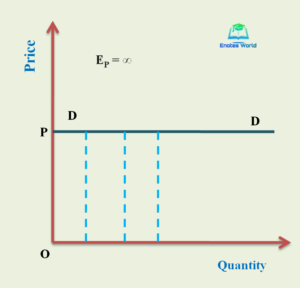
The demand curve DD is parallels to X-axis shows the perfectly elastic demand. It is a straight line parallel to the X-axis. It displays that tiny alteration in price origins infinite fall or rises in quantity demanded. This type of elasticity is considered as the upper limit of elasticity.
Perfectly Inelastic Demand (EP = 0)
The demand is known as perfectly inelastic when the demand remnants persistent whatever may be the price (i.e. price may rise or fall). Thus, it is also named zero elasticity. In this degree of elasticity, the demand quantity remains the same irrespective of any rise or fall in the price of the commodity. It also has no real-world standings. The following figure shows the demand curve of perfectly inelastic demand.
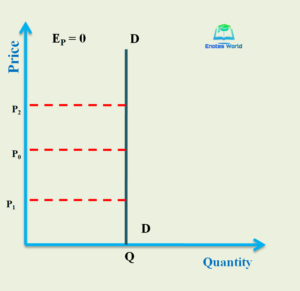
A demand curve for zero elasticity is known as a perfectly or completely inelastic demand curve. The demand curve DD is parallel to Y-axis, perfectly inelastic demand curve. The quantity purchased remains OQ irrespective of whether the price is OP or OP1. The case of zero elasticity of demand is very rare even in the case of necessities of life like food as demand for even necessities also changes because of change in their prices.
Unitary Elastic Demand (Ep =1)
The demand is called unitary elastic demand when the proportional changes in the price of a product result in a similar proportionate change in the quantity demand. For instance, if an 11% change in price primes to exactly 11% change in quantity demand then this is unitary elastic demand. It is also an imaginary one as it is hardly relevant in our everyday lifecycle. The following diagram shows the concept of unitary elastic demand.
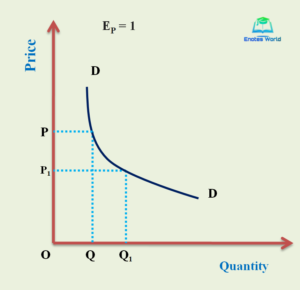
The demand curve DD is a unitary elastic demand in the rectangular hyperbola shape. It demonstrates that the demand is unitary elastic. The fall in price from OP to OP1 has caused an equal proportionate increase in demand from OQ to OQ1. Similarly, when price increases, the demand decreases in the same proportion. The demand curve DD’s extent never touches either axis. Therefore, the demand curve represents unitary elastic demand.
Relatively Elastic Demand/Elastic Demand (EP> 1)
The demand is referred to as relatively elastic when the proportion alteration in demand is larger than the proportion alteration in price i.e. if there is a bigger change in demand due to a small change in price. It is also named highly elastic demand or simply elastic demand. For example; If the price falls by 7% and the demand rises by more than 7% (say 10%), then it is an instance of elastic demand. The demand for luxurious goods such as high-quality cars etc. is an elastic one. The following diagram shows the elastic demand curve.
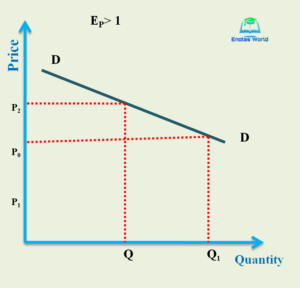
In the above figure, the demand curve DD shows relatively elastic demand. The P and Q is the initial price-quantity combination. When there is a decrease in the price from P to P1 then demand quantity has increased from Q to Q1. Here the percentage change in quantity demand is higher than that of the price of the product. The numerical value of elasticity is greater than one in such a case.
Relatively Inelastic Demand/Inelastic Demand (Ep< 1)
The demand is called relatively inelastic when the proportionate change in quantity demanded of a commodity is lesser than that of the price of the commodity. It is similarly named less elastic or inelastic demand. For instance, when the price falls by 9% and the demand rises by less than 9% (say 7%), then it is the instance of inelastic demand. The demand for goods of daily consumption necessities is inelastic.
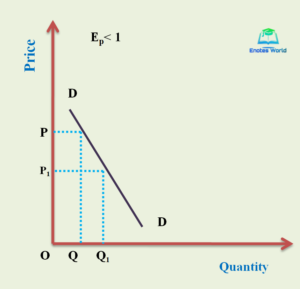
In the above figure, the demand curve DD shows the inelastic demand of a commodity. The figure depicts that the percentage change in price is grander than that of quantity demand.
The following table summarizes our overall description regarding the concept and degree or types of price elasticity of demand.
| Types of Elasticity | Numerical Value of Elasticity | Description |
| Perfectly Inelastic | ep=o | Quantity demanded does not change with change in prices |
| Inelastic | ep is less than 1 | Quantity demanded changes by the lesser proportion than that of price |
| Elastic | ep is greater than 1 | Quantity demanded changes by a larger proportion than a change in price. |
| Unitary Elastic | ep = 1 | Quantity demanded changes exactly at a similar rate of change in price. |
| Perfectly Elastic | ep is infinite | Consumers are prepared to buy all they can get at a small price but none at all at a slightly higher price. |
The following figure shows the degrees of price elasticity of demand;
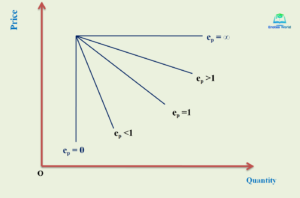
Conclusion
Price elasticity of demand measures by how much quantity demanded of good changes/the responsiveness of quantity demanded with a given change in the price of the product, ceteris paribus. The extent or degree of responsiveness of quantity demand with the change in price may differ from one good to another. This phenomenon has explained by the various degrees of price elasticity of demand. The mathematical value or the coefficient of the price elasticity of demand lies between zero to one or between the imaginary situation of price elasticity namely, perfectly elastic demand and perfectly inelastic demand. From this, we get the ideas regarding concept and degree of price elasticity of demand. In our next article, we will talk about the measurement of price elasticity of demand.
References and Suggested Readings
Adhikari, G.M. and et.al. (2019). Microeconomics for Business. Kathmandu: KEC Publication
Dhakal, R. (2019). Microeconomics for Business. Kathmandu: Samjhana Publication Pvt. Ltd.
Mankiw, N.G. (2009). Principles of Microeconomics. New Delhi: Centage Learning India Private Limited
Salvatore, Dominick. (2003). Microeconomics: Theory and Application. Oxford University Press, Inc.
Shrestha, P.P. and et.al. (2019). Microeconomics for Business. Kathmandu: Advance Sarswati Prakashan.